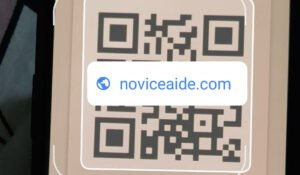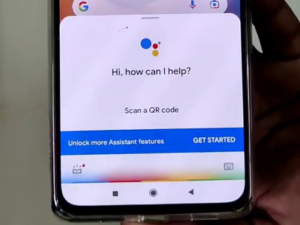Smartwatches live or die by a simple equation: how well they combine reliable health tracking, everyday practicality, and a design you actually want to wear. The Titan Maestro leans into that equation with a premium stainless-steel build, a bright and responsive display, and a feature set that aims to serve both fitness routines and daily life. After using it as my primary watch for about 6 months—tracking workouts, wearing it to work and on occasions, and testing battery stamina—this is my comprehensive account of what the Maestro does well, where it stumbles, and what prospective buyers most often want to know.
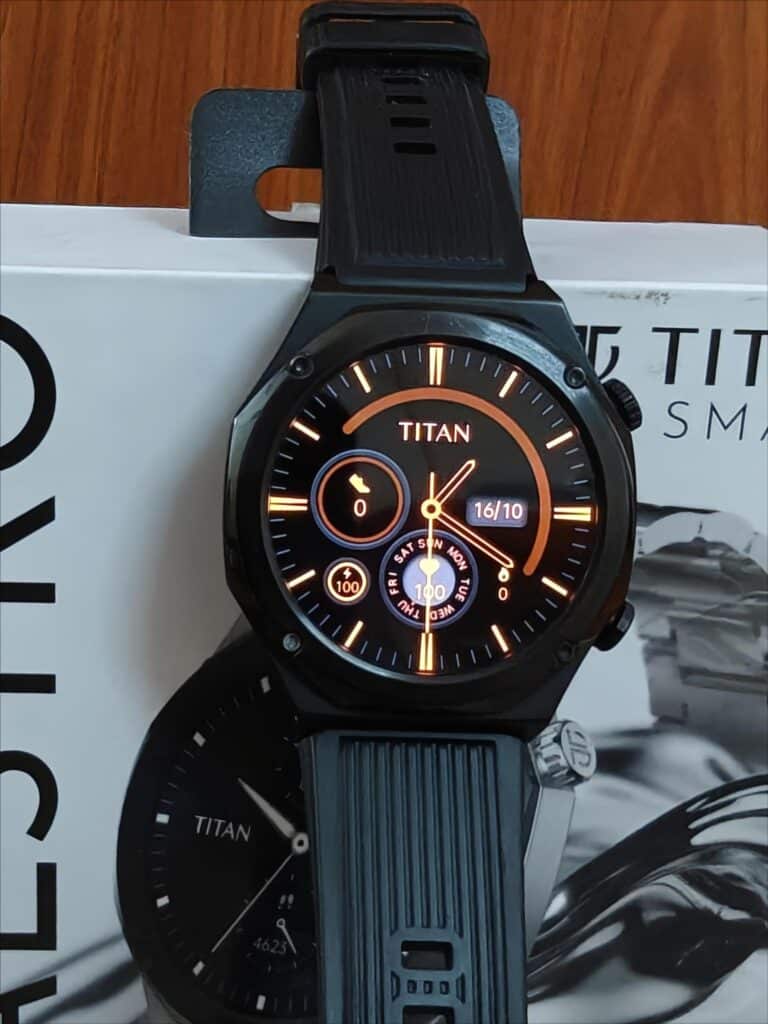
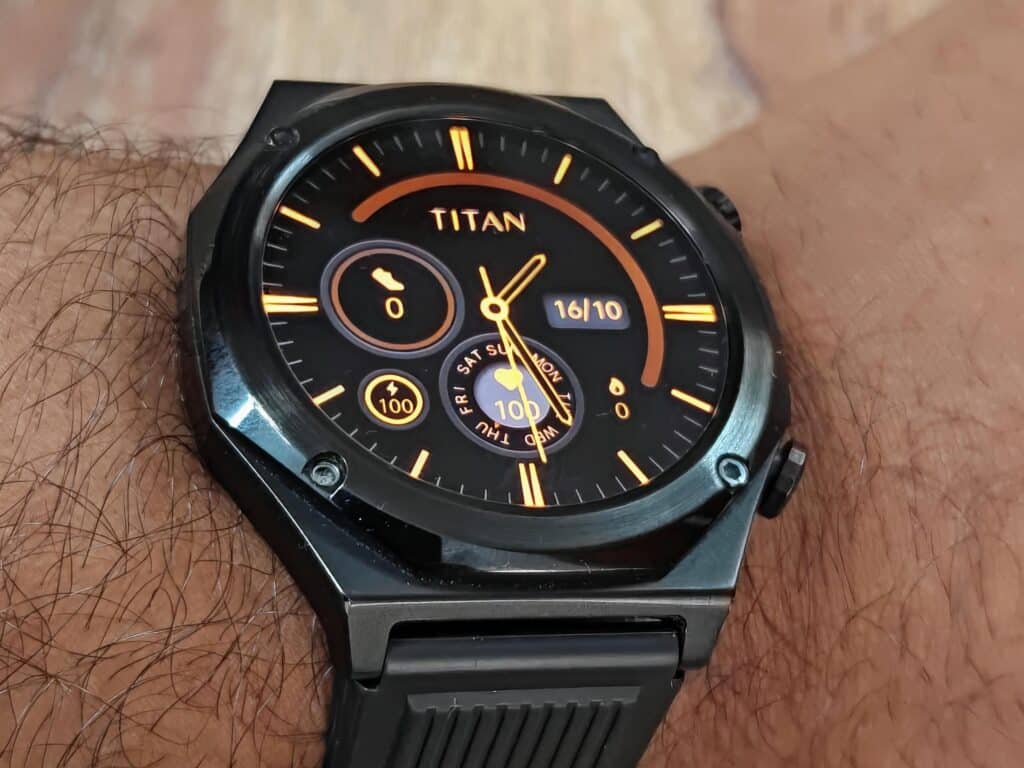
Design & Build Quality: Premium Where It Matters
The first impression the Titan Maestro delivers is unambiguously premium. When I went to the Titan Shop to buy a Smartwatch to replace my ever faithful OnePlus Watch, I was torn between two of their models. The Titan Celestor and Maestro. The Maestro won the completion with its premium look, slightly better battery life and the option to have a premium stainless steel strap in addition to the silicone one.
The stainless-steel case gives the watch a reassuring solidity on the wrist—this is not a flimsy, hollow-feeling gadget. Titan’s design team has made a particularly smart choice with the glass sitting slightly recessed beneath the surrounding metal. In day-to-day use, that small depth difference pays real dividends: when you brush against a door frame or catch a stray bump during a crowded commute, the metal rim tends to take the hit, not the glass. It’s a subtle design cue that inspires confidence.
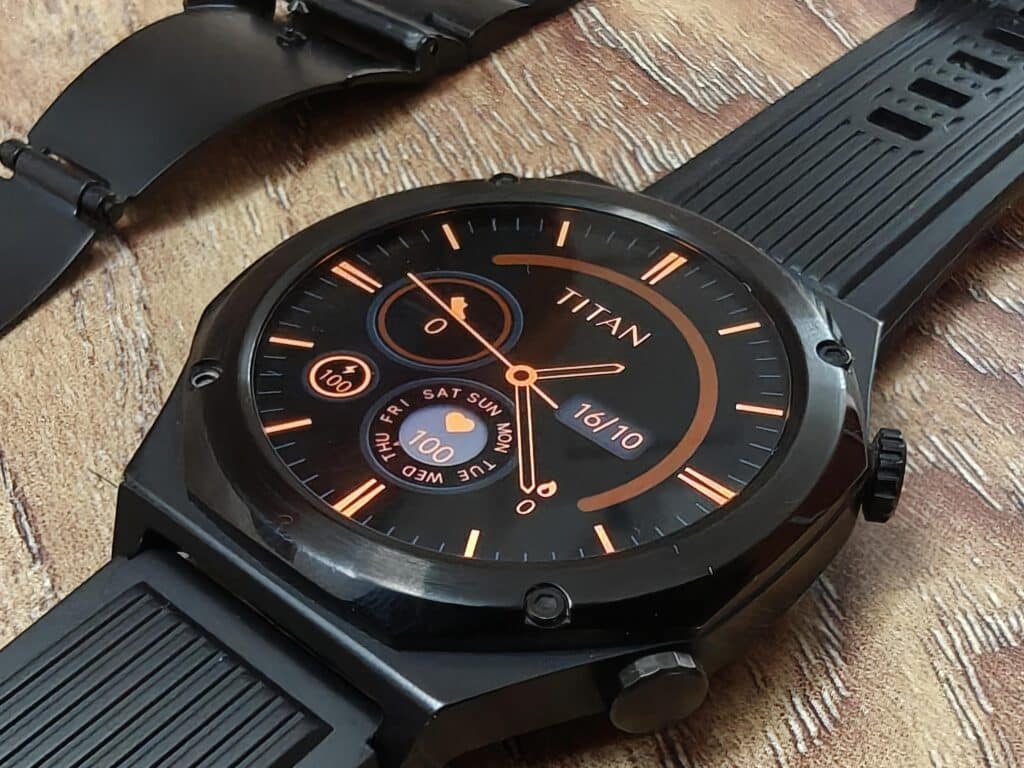
From a fitness perspective, it’s easy to think of “premium metal” as something you wear to meetings rather than to the gym, but the Maestro manages to bridge both worlds cleanly because of one decision that feels minor on paper and major in practice: two included straps. The silicone strap is the default for workouts—comfortable, sweat-friendly, and light enough that it doesn’t distract while you’re moving. The metal strap elevates the look instantly, perfect for occasions or office wear. The quick-release mechanism makes swapping a 30-second affair, so you’re never locked into one identity for the day.
Is there a trade-off? Yes. The stainless-steel body means the Maestro is slightly on the heavier side. During the day this weight translates to a feeling of quality; during the night, particularly if you attempt sleep tracking, it can become noticeable. I tried sleeping with it a few times and found the weight just a bit intrusive for all-night wear. This isn’t a flaw so much as a design reality: premium steel has mass. If you plan to track sleep every night, you’ll either acclimate over time or prefer to wear it only on nights when you specifically want sleep data.
Durability, at least in my months of use, is a strong point. The recessed glass and steel shell have kept the watch looking new despite normal knocks and some gym scuffs. Through there is a loss of one screw among the four on frame, I’m far less anxious about incidental bumps with this design than with flush-glass watches.
Display quality is crisp and punchy, with good responsiveness to wrist raise. Colors read cleanly in bright environments, and indoor legibility is excellent. While there’s no auto-brightness adjustment, manual control is straightforward, and once you find the sweet spot for your environment you’ll rarely think about it again. Personally, I keep raise-to-wake enabled at all times and Always-On Display (AOD) off to maximize battery life (more on that later).
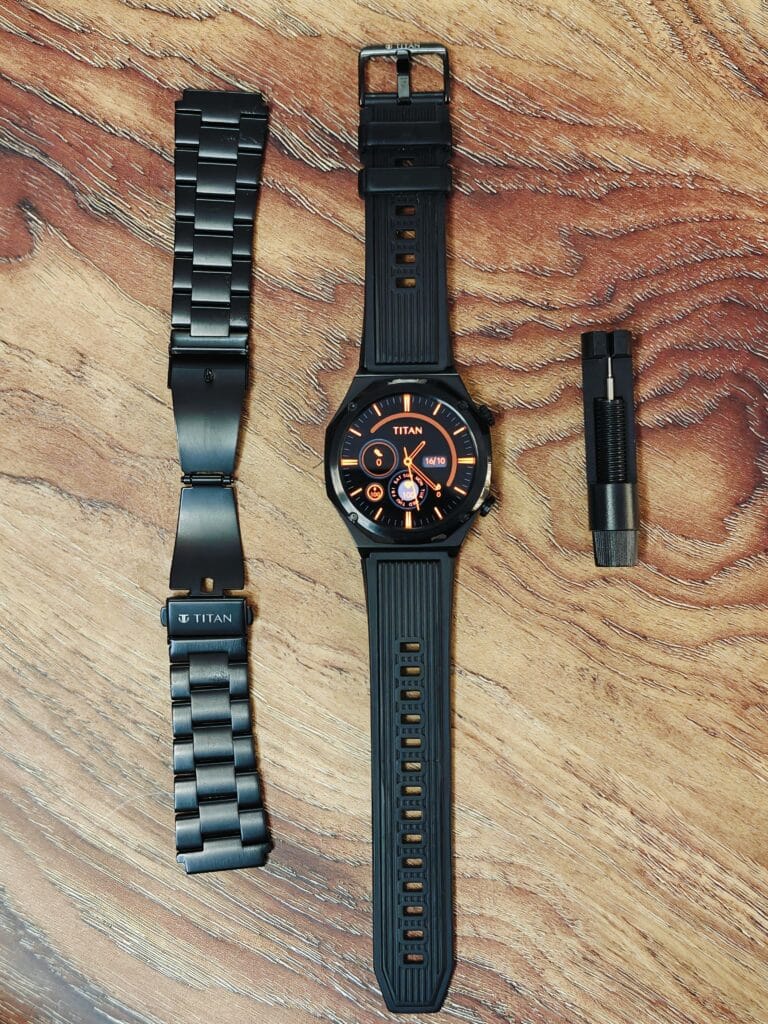
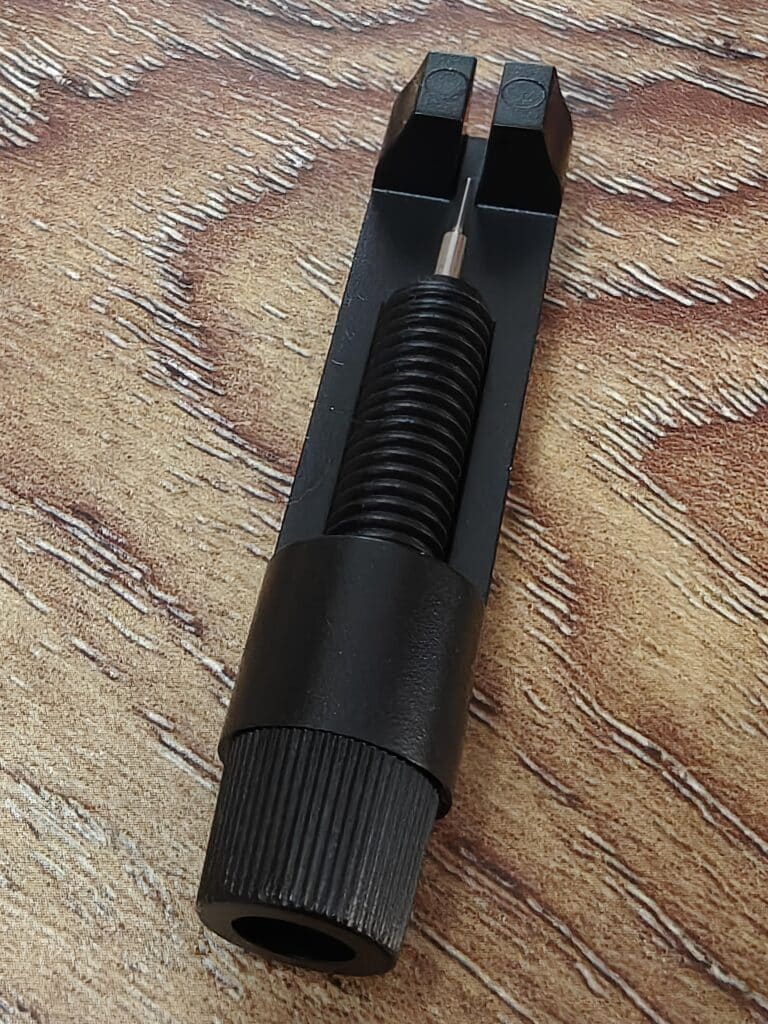
Fitness & Health Tracking: Accurate Core Metrics With One Notable Quirk
If a smartwatch can’t track health credibly, the rest is window dressing. The Titan Maestro focuses on a clear essentials-first approach: steps, heart rate (HR), sleep, SpO₂, stress, and a set of workout modes that cover common activities. The execution across these pillars is consistently good, with heart-rate accuracy being a particular highlight.
Heart Rate, Steps, and Workout Modes
In steady-state efforts—think moderate running, zone-2 cardio, or brisk walking—the heart-rate readings are stable and believable, matching perceived exertion. During interval work with sudden spikes, the sensor responds quickly enough to be useful for pacing and effort feedback. Step counts track accurately through the day without the obvious inflation you sometimes see from wrist gestures. The workout screens provide the expected at-a-glance metrics (duration, HR, calories, etc.), and the post-workout summaries in the companion app are clean and digestible.
The breadth of workout modes covers the basics well. If your routine includes running, walking, cycling, bodyweight sessions, or gym circuits, you’ll feel at home with the selection and the data captured. If you’re an enthusiast chasing niche sport metrics (like advanced trail-running stats or sport-specific drills), Titan Maestro isn’t trying to be a specialized performance computer—it’s aiming to deliver solid, dependable tracking for mainstream fitness needs.
Automatic Tracking: Helpful… but Mind the Reset
There’s one behavior prospective buyers should know about up front. The automatic activity detection is useful for those times you start moving and forget to manually begin tracking. However, when the watch recognizes that you’re active and prompts you to start a formal workout, accepting that prompt starts a new session from zero—which means you lose the activity recorded up to that point. Practically, if you’ve already been walking for 12 minutes and only then accept the prompt, the “tracked” session begins at minute 12 and discards the earlier effort.
Workaround: If you’re particular about keeping your full session intact, start workouts manually as a habit—especially for planned exercise. Auto-detection remains a nice safety net, but it shouldn’t be your primary trigger if you care about complete data continuity. This is a software-side opportunity for Titan: ideally, detected pre-activity should be merged into the newly confirmed session rather than reset.
Sleep, SpO₂, and Stress
Sleep tracking, on nights I wore the watch, was accurate enough to be useful, capturing duration and sleep stages with results that matched how I felt the next morning. The caveat again is comfort: the watch’s weight makes it less ideal for nightly wear unless you personally don’t mind the heft. SpO₂ and stress features are good for trend awareness—they are not medical-grade diagnostics, but they add context to how your day is going and how workouts might be affecting recovery.
Battery Life & Charging: The Titan Maestro’s Superpower
If there’s one specification that truly defines the Titan Maestro in daily life, it’s battery life. With AOD off and raise-to-wake on, plus regular notifications and workout tracking, I consistently see 30+ days on a single charge. That’s not a lab number; it’s my lived experience. For people who prioritize fitness and want a watch that doesn’t become yet another device they need to remember to charge every night (or even every week), this is transformative.
A long-life battery changes behavior. You don’t micromanage features for fear of draining it, you don’t bring a charger on short trips, and you’re not forced to choose between night charging and sleep tracking. If you do enable more power-hungry features (e.g., frequent calling, bright screen at all times), your range will narrow, but the baseline endurance is so strong that a “heavy week” still feels relaxed compared to most smart devices.
Charging itself is predictable and uneventful: top it up, forget about it for weeks, repeat. In a world of gadgets constantly vying for outlet time, this might be the Maestro’s single most persuasive argument.
Everyday Smart Features: The Right Basics, Some App-Only Toggles
A great fitness watch that frustrates you during normal living won’t last on your wrist. The Titan Maestro’s notifications are consistent, readable, and timely. You’ll see messages and app alerts; interactivity is limited (as is typical in this class), but for most of us the primary need is “Did someone message me, and do I need to check my phone now?”—which the Maestro satisfies cleanly.
Bluetooth calling works reliably. I don’t rely on the feature in daily life, but in testing, call clarity on both ends is accurate and serviceable for short conversations. It’s the sort of feature you appreciate when your phone is in a bag or another room.
One daily-life quirk worth noting: the hourly hydration reminder is a thoughtful nudge for wellness, but it can only be disabled via the companion app, not directly on the watch. It’s a small friction point—ideally, quick toggles for common reminders and alerts would exist on the device itself. Still, this is solvable: once you’ve configured reminders to your liking in the app, you rarely revisit the setting.
Software & App Experience: Clear Summaries, Minimal Friction
The Titan Maestro’s companion app organizes the essentials with clean summaries and free-from-clutter charts. Post-workout breakdowns are readable without requiring a data-science degree. Daily dashboards consolidate steps, active minutes, HR trends, and sleep in a way that’s quick to scan and easy to interpret. Syncing is stable, and in my use, pairing is set-and-forget—exactly what a watch should be.
There are places the software could evolve: merging pre-detected activity with manual sessions, allowing more toggles on-device (like the hydration reminder), and perhaps exposing a few more advanced workout metrics for power users. But the core day-to-day experience is stable and predictable, which matters more than a laundry list of features you rarely touch.
Comfort & Long-Term Wear: Good Balance With Strap Choice
For daytime wear, the Titan Maestro with the silicone strap strikes a good balance of grip, flexibility, and sweat resilience. The metal hardware on the case doesn’t cause hot spots, and the silicone manages moisture well enough that I never felt the need to take the watch off mid-workout. With the metal strap, the watch pivots into dress mode: you’ll feel a bit more mass, and you’ll gain a lot more polish. The option to change personality in seconds is one of the most practical design aspects of the package.
For sleep, your mileage will depend on how sensitive you are to weight. The sensor bump is unobtrusive, but the overall mass is greater than many plastic or aluminum wearables. I wore it overnight selectively and found sleep data credible when I did, but personally choose the couch over the bed for nightly tracking here—daytime metrics are where I care the most, and that’s where the Maestro excels.
What the Titan Maestro Gets Right (and Why It Matters)
1. Battery Life That Rewrites Habits
Two-plus weeks on a charge changes how you relate to a smartwatch. You stop treating the watch like a fragile gadget and start treating it like a dependable instrument. It’s hard to overstate how freeing this is.
2. Build That Can Take a Knock
The recessed glass and steel case are more than aesthetic choices—they’re functional durability features. I’m less protective with the Titan Maestro than with flush-glass watches, and it still looks pristine.
3. Fitness Metrics You Can Trust
Steps and heart rate are reliably accurate, workouts capture useful core data, and sleep (when worn) makes sense. I don’t find myself second-guessing the numbers.
4. Two Straps, Two Roles
The included silicone and metal straps make the Titan Maestro effectively two watches in one: one for the gym bag, one for the blazer pocket. That flexibility amplifies value. As the watch comes with a tool to change the straps, you don’t need to visit a shop to change it.
5. Everyday Sanity
Notifications land, calls work, reminders nudge—no fuss. It’s not trying to be a smartphone on your wrist; it’s trying to be just smart enough, and it mostly nails that brief.
What Could Be Better (and How to Work Around It)
1. Auto-Tracking Reset
The biggest quirk: accepting an auto-detected workout prompt starts a new session and drops prior activity. Workaround: Start workouts manually to retain full sessions.
2. Slightly Heavy for Sleep
The steel case is wonderful by day, a bit much by night. Workaround: Use sleep tracking intentionally on nights when you want the data; skip it on others.
3. No Auto-Brightness
Manual brightness is fine 90% of the time; it’s that 10% of rapid environment change where auto-brightness would be handy. Workaround: Add brightness to your muscle memory; it’s a quick adjustment.
4. App-Only Toggles (Hydration Reminder)
More on-watch toggles would reduce small annoyances. Workaround: Configure reminders once in the app and move on.
Practical Tips to Get the Most From the Titan Maestro
- Make manual workout start a habit. If data completeness matters to you, don’t rely on auto-start. A two-tap habit prevents session resets.
- Use raise-to-wake + AOD off for best battery life. This combo delivers multi-week endurance without sacrificing responsiveness.
- Lean on the silicone strap for training. Sweat management and comfort are better; swap to metal for the office or events.
- Schedule “battery checks” weekly—then forget about it. You’ll be surprised how often you still have >50% remaining.
- Configure alerts in the app up front. Especially the hydration reminder. Set it once and you won’t think about it again.
Frequently Asked Questions (From a Real User’s Perspective)
Is the fitness tracking accurate enough for serious training?
For heart rate, step count, duration, and calorie estimates: yes. The Titan Maestro’s tracking is consistently credible for mainstream fitness and structured workouts. If you rely on granular, sport-specific advanced metrics, this is more of a reliable daily trainer than a lab instrument, and that’s by design.
How’s the heart-rate sensor during intervals or lifting?
It tracks changes quickly enough to be useful during tempo and interval sessions and reflects effort well in resistance training where HR tends to spike and settle repeatedly.
Can I rely on auto workout detection?
It detects activity and prompts, but accepting the prompt resets the session, losing prior minutes. Treat auto-detect as a helpful nudge, not your primary tracking method. Manual start is best.
Is it comfortable for all-day wear and workouts?
Absolutely with the silicone strap. Breathability and flexibility are good; I never felt compelled to remove it mid-session. The metal strap is for style, not sweat.
What about sleep tracking?
Accurate when used, but the watch is a bit heavy for nightly wear. I track sleep selectively.
How good is the battery life really?
With Always-On OFF, raise-to-wake on, and normal notifications + workouts, I routinely get 30+ days. That’s been a repeatable real-world outcome, not a theoretical claim.
Does Bluetooth calling actually work?
Yes. Call clarity is solid for short calls. I don’t use it extensively, but when I tested it, it behaved as expected.
Can I disable the hourly hydration reminder on the watch?
No. You’ll need to toggle it in the companion app. It’s a small annoyance but a one-time setup.
How’s the display outdoors?
Bright and readable. Without auto-brightness, you’ll occasionally tweak levels manually, but legibility in daylight is good.
Is the glass of Titan Maestro easy to scratch?
The recessed design helps significantly. In day-to-day use, occasional bumps hit metal first, and my glass has stayed scratch-free so far.
Who the Titan Maestro Is For
- Fitness-first everyday users who want accurate core tracking without babysitting a charger.
- Professionals who want a watch that looks premium at work and can double as a training partner after hours.
- Pragmatists who value durability and predictable software over experimental features.
- Battery-life maximalists who don’t want their wrist device to become a nightly charging ritual.
Who Might Want Something Else
- Ultralight sleepers who need a barely-there watch for nightly wear.
- Metrics obsessives who demand sport-specific analytics beyond mainstream fitness tracking.
- On-device tinkerers who expect every toggle and setting to be accessible from the watch rather than the app.
Final Verdict: A Dependable Fitness Companion with Premium Bones
The Titan Maestro succeeds by focusing on the aspects that make a smartwatch livable: excellent battery life, credible fitness tracking, and a build you’re not afraid to wear. Its stainless-steel case and recessed glass carry real benefits in the real world. The fitness suite delivers the truth you need—HR, steps, duration, sleep when you want it—without turning every workout into a data science project. And the two-strap approach neatly solves the “gym vs. office” dilemma without forcing you to own two devices.
Is it perfect? No. The auto-tracking reset behavior needs refinement, and auto-brightness would be a quality-of-life upgrade. The watch’s weight makes it less than ideal for nightly sleep tracking, and a handful of app-only toggles (like hydration) would be better mirrored on-device. But none of these are deal-breakers; they’re the kind of edges that can be smoothed in future software updates or simply worked around with a few smart habits.
What you get in return is a watch that’s reliable, durable, and remarkably low-maintenance—a companion that amplifies your fitness routine and fits your day without demanding constant attention. If your priorities read battery, build, and believable tracking, the Titan Maestro earns a confident recommendation.
If you liked this post, consider reading up on what I was using earlier, Learn All About The Watch Faces on a OnePlus Watch. Change, add, delete, and create watch faces on a OnePlus Watch[Video] and boAt Storm Smart Watch user review and common questions

